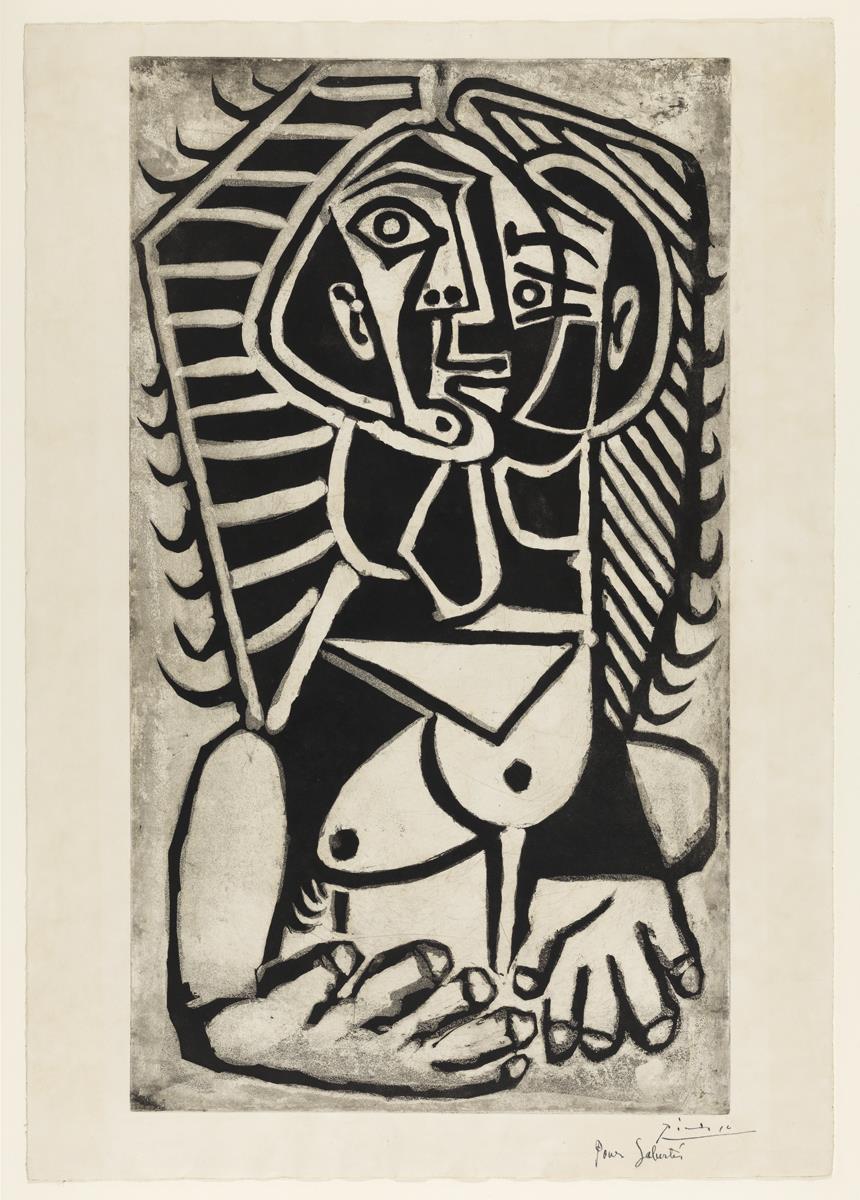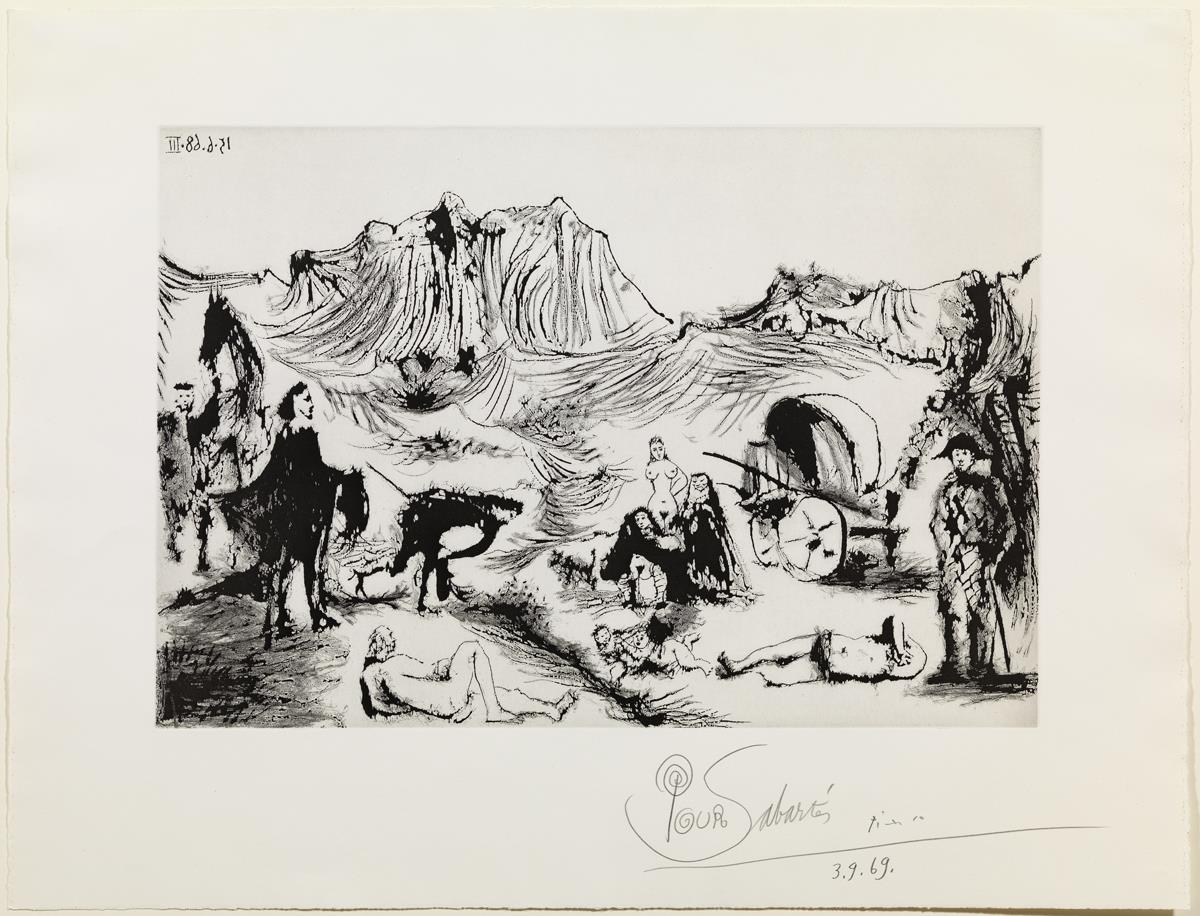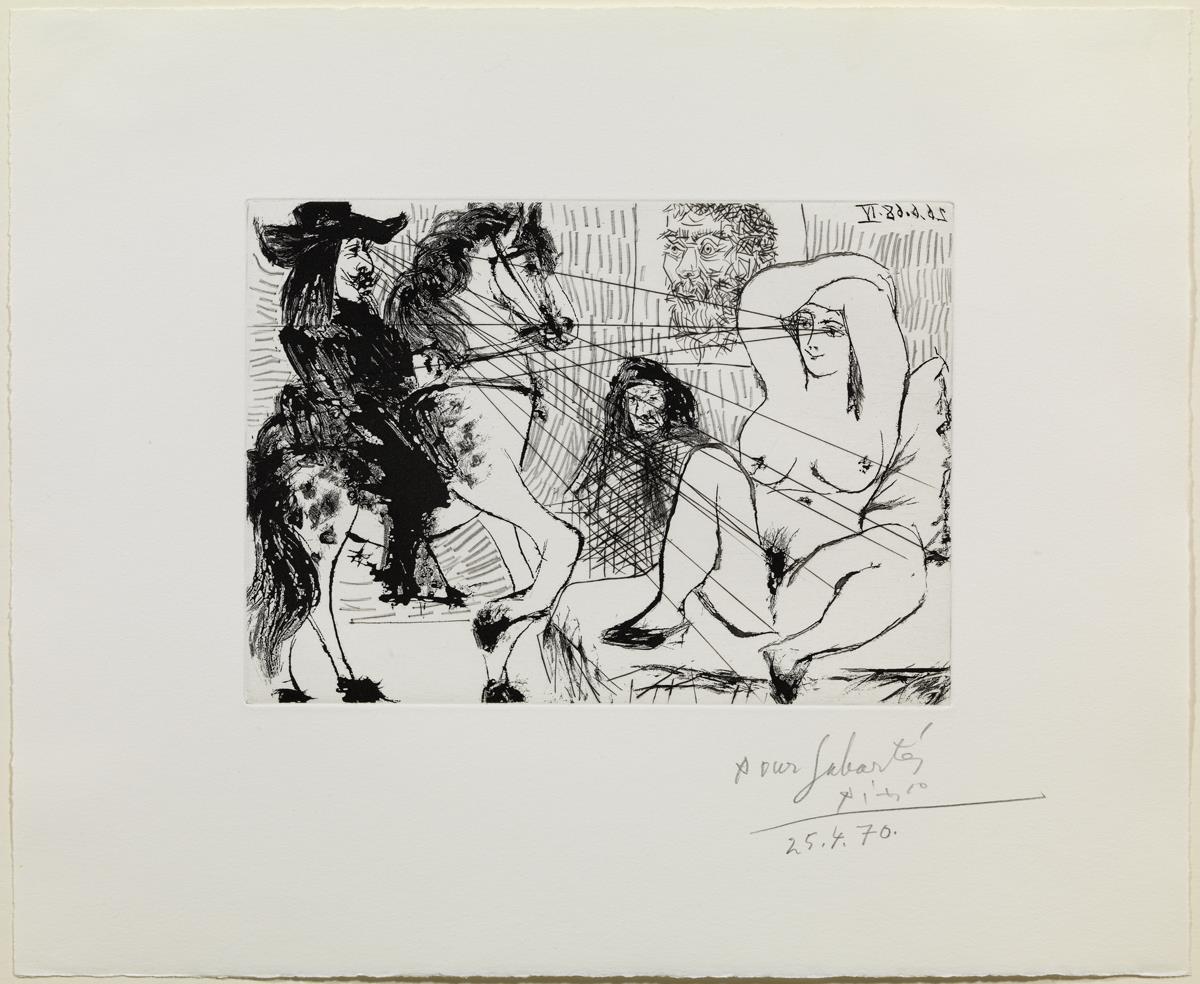The aquatint is one of the main procedures for etching in metal or intaglio printmaking, and in this type of etching the incisions or grooves are deep. This technique of indirect incision etching or of corrosion by mordant was highly used by Picasso, in a specific way or as a mixed technique.

Pablo Picasso. Childhood memories: street festival with a funny chap and El gigante. Mougins, 4th June, 1968 (I). Sugar lift aquatint on partially greased copper plate, printed on Rives vellum paper (Sabartés proof). 22.5 x 29 cm (plate); 35.1 x 42 cm (paper; irregular). Gift of Pablo Picasso, 1970. Museu Picasso, Barcelona. Photo: Estudi Gasull. MPB 70.651
One of the variants of aquatint is sugar-lift aquatint. In this technique sugar is mixed with Chinese ink or gouache or gum Arabic, or other substances that dry very quickly and dissolve easily in water. With this mix you can draw with a paint brush or pen on a plate previously coated in resin. When the drawn image is dry, the plate is covered with a protective varnish, or etching ground, and it is then introduced into a bath of water. The water makes the mixture with the sugar lift off the plate and the drawing is left uncovered or bare. In this way, when the plate is placed in an acid bath, this etches the form that has been initially drawn with the mixture.

Pablo Picasso. Tree in the storm, with flight towards a church. Mougins, 15th August, 1968 (III). Sugar lift aquatint on greased plate and drypoint on copper plate, printed on Rives vellum watermarked paper (Sabartés proof). 20 x 32.5 cm (plate); 31.5 x 45.1 cm (paper). Gift of Pablo Picasso, 1970. Museu Picasso, Barcelona. Photo: Estudi Gasull. MPB 70.597
Aquatint was invented by the French artist Jean-Baptiste Le Prince around 1760 to obtain pictorial halftones so as to be able to apply them to etchings of the reproductions of the paintings. With their aspect similar to that of watercolours or wash, the aquatint also allows you to obtain reticular pictorial sections and beautiful gradients.
Picasso was introduced into this technique by the printer Roger Lacourière. He cultivated it in a masterly way throughout his life and he became the main architect of this variant, sugar-lift aquatint, the technique that he boosted in a decisive way and with which he created some of his most notable etchings. Picasso expressed to his companion Françoise Gilot: «with sugar-lift aquatint everything is more direct and at the same time more delicate» (Life with Picasso, 1965).


Pablo Picasso. Old man thinking about his life: gallant youth, maturity of famous painter, work created in a slum and now glorified under a canopy bed . Mougins, 28th May, 1968. Sugar-lift aquatint (partially greased plate) with some touches on the varnish and with a cane on the sugar-lift, on copper plate, printed on Rives vellum paper (Sabartés proof). 49.5 x 33.5 cm (plate); 66 x 46.5 cm (paper). Gift of Pablo Picasso, 1970. Museu Picasso, Barcelona. Photo: Estudi Gasull. MPB 70.616 | Pablo Picasso. The egyptian. Paris, 11th May, 1953. Sugar lift aquatint on copper plate, printed on Arches vellum watermarked paper. 83 x 47.5 cm (plate); 49.1 x 63.5 cm (paper). Gift of Jaume Sabartés, 1962. Museu Picasso, Barcelona. Photo: Estudi Gasull. MPB 70.222
This summer, our museum presents a selection of more than thirty sugar-lift aquatints that help to highlight the expressive potential and creative genius of Picasso.The prints gather together iconographies, motifs, themes and some of his classic genres, such as the woman, the embrace or the landscapes (not very frequent in the etching work of Picasso), amongst others. There is also a proliferation of the topic of the painter and the model, which, within his work, becomes an artistic genre.

Pablo Picasso. Variation on Don Quixote and Dulcinea: A stopping place for travelling actors. Mougins, 15th June, 1968 (III). Sugar lift aquatint on greased copper plate, printed on Rives vellum paper (Sabartés proof). 33.7 x 49.4 cm (plate); 50.1 x 65.5 cm (paper). Gift of Pablo Picasso, 1970. Museu Picasso, Barcelona. Photo: Etudi Gasull. MPB 70.624
The selection presents a series of prints outside his usual context, the two major series known as the 347 etchings and the 156 etchings respectively. They are an exponent of the Picassian universe from the later years of his life, in which all types of characters appear, some of whom having accompanied him from the beginning of his artistic career: clowns, acrobats, strongmen, painters, models, kids, young children, old men and women, dwarfs, etc. The participants of a parade in which, print after print, etching after etching, the old etcher would play on their experiences, desires, wishes and fears.

Pablo Picasso. Maison Tellier. The manageress’s party. Owl. Degas leaning on the wall. Mougins, 14th and 16th June, 1971. Sugar lift aquatint, mordant applied with a brush, drypoint and scraping on copper, printed on Rives vellum paper (numbered artist’s proof). 22.9 x 30.6 cm (plate); 36.3 x 45.3 cm (paper). Gift of Picasso's Family, 1980. Museu Picasso, Barcelona. Photo: Estudi Gasull. MPB 112.269
That's why it should be of no surprise to discover the presence of these figures or the references to his much-admired masters: Velázquez, Rembrandt, Goya, Manet, etc. And we shouldn't be surprised either by the appearance of illustrious members from literature —la Celestina, Don Quijote and his inseparable Sancho Panza, Dulcinea, etc., nor the references to the adventure films that the French television broadcasted during that period.
As with a large part of his work, in these prints the etcher mixed the cultured world with the popular world, summoning Olympians, gentlemen and pimps along with folk parades of giants. A timeless potpourri, all squeezed together and bustling, a major plastic wealth.
Picasso, at the end of his life, returned to the topic of brothels, to la maison close. In his works he incorporated another artist: Degas, the author of the series of monotypes of La Maison Tellier that he liked so much, to the extent that he collected quite a number of them.

Pablo Picasso. Exchange of glances. Mougins, 26th June, 1968 (IV). Sugar lift aquatint, drypoint and direct scraping on copper plate, printed on Rives vellum paper (Sabartés proof, II and final state). 15 x 21 cm (plate); 28.5 x 34.7 cm (paper). Gift of Pablo Picasso, 1971. Museu Picasso, Barcelona. Photo: Estudi Gasull. MPB 111.867
The etcher, now an old man, would enter la Maison Tellier by the hand of Degas. He narrated in a number of etchings the experiences of Degas, an avid voyeur, within the house where they were received by the madam, who was holding a party accompanied by her exuberant girls, while the others were resting. Picasso/Degas watched and observed. The glances!
The glance is the protagonist of many of the sugar-lift aquatints selected. Its role is so important in these etchings, that Picasso dedicated an etching to it entitled Exchange of glances. The etcher traced the directional lines of the points of attraction of the multiple glances of the two protagonists, that in many cases cross over, and also includes that of the spectator. Beyond the structural game, the look creates the dramatic tension of the work, which, like many others, acts as a reclamation for the desire frustrated by impotence, voyeurisme, old age, and death. All in all, Eros and Thanatos.
The selection of aquatints will be open until 20 September in the galleries of the collection and can be followed through our social networks under the hashtag #SeleccióPicasso.
Claustre Rafart Planas
Collection
Related links
Life with Picasso, by Françoise Gilot in the Reading Club







